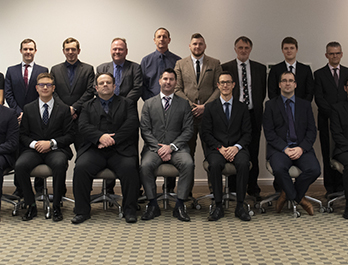
The background
Interm IT is a family-run education-only technology support company, with consultants visiting schools to resolve issues and forward plan the technology needs of that school. Those consultants are in turn backed up by an excellent support desk that is available at the end of a phone line when there is no consultant present. They work with around 200 schools in the Hertfordshire region – supporting both Primary Schools – who feel unable to employ their own on-site technology resource – along with some Secondaries and Sixth-Form Colleges – who believe this model is more cost effective for them.
The company has been in business since the Year 2000, working with a range of suppliers themselves – including RM – a partner since 2003. The initial engagement with RM was with their network management software, which has evolved into becoming a partner for connectivity services, which has evolved to include full Broadband support (i.e. including online security and filtering) – something that has been in high demand in schools – especially those in the London boroughs. More recently the two are working together on MIS solutions for schools.
“We are very proud of our relationship with RM”.
Richard Spragg, Managing Director

Working in partnership
Whilst – on the face of it – Interm IT and RM may appear competitors, the reality is that this is a good example of true partnership. RM was historically under-represented by their own onsite engineers in the Hertfordshire region but had an award-winning connectivity capability, so working with Interm IT gave them the opportunity to promote their solutions in a cost-effective way. From Interm IT’s perspective, they needed a reliable connectivity partner that they could trust, enabling them to focus on their role as a proven support provider.
As schools have adopted more and more technology, their reliance upon it has grown – ensuring that what they have works, whilst exploring new opportunities all the time.
“For us, we need partners we can depend upon, in the same way that schools rely on us. Someone who turns new quotes around quickly, can resolve queries as they happen, and generally have the scale to respond at pace. Compared to their competitors, RM are second to none – their Account Managers are simply outstanding”.
Richard Spragg, Managing Director
It is this scale and understanding of the uniqueness of the education setting, that brings Interm IT and RM together so well.
“The team at RM will always look for a workaround when they are unable to provide me with what I have asked. This is even the case when it is not their customer – they always do what is right for the school”.
Richard Spragg, Managing Director
RM’s connectivity proposition allows every school to have their own bespoke configuration – unlike most other providers whose systems tend to be “one size fits all”. Many schools welcome the flexibility that the RM approach allows, giving their teams the ability to manage their connectivity (firewall and filtering) directly. This is especially welcomed by Interm IT, describing it as their “Single Pane of Glass” portal, allowing their consultants to manage all of their schools through one view – overseeing what is happening, activating individual connectivity nodes, whilst putting in place rules across a whole estate. It also means that the technicians do not need to raise individual support tickets – most things can be resolved there and then.
“For us, this is a huge USP that RM provides. It allows us to be ultra-responsive to our customers, and I do not see any other Internet Service Provider offering this on the market. When it comes to matters like Safeguarding, you do not have time to waste”.
Richard Spragg, Managing Director

The role of technology in a modern school environment
Schools have been alive to the role of technology for many years, and the advancement of cloud technology has been on the radar of most – even Primary Schools. The pandemic – when it hit in March 2020 – served to accelerate this move to the cloud – perhaps by as much as seven years.
“In our experience, schools have been inching towards a more cloud-based infrastructure for 10 years or more. We were virtualising schools in 2011/12 using VM Ware and RM’s own CC4 network, and over time we have installed Sharepoints and increasingly Office 365 software. Those schools that made the most out of our consultancy and planning had the foundations already in place – so that by leveraging the cloud technologies that they had – alongside the strengths of our partners – they were very quickly able to adapt to the new ways of operating at the height of the pandemic”.
Richard Spragg, Managing Director
The pandemic coincided with the roll out of Chromebooks and both Google Workplace and Microsoft Teams – in many cases backed by funding by the Department for Education. Whilst many schools were already on this journey, for others it was the impetus they needed.
“Like most sectors there are always some staff who are resistant to change. The reality was – however – that when lockdown came, schools had little choice but to adopt some form of remote teaching. In the Spring of 2020, when Lockdown was first announced, I think most schools were waiting to return to the more traditional approach; but by the end of Lockdown in early 2021, there was no way they would go back”.
Richard Spragg, Managing Director
Throughout all of this, the one aspect of technology that is often overlooked, is the role of connectivity. It is the glue that makes everything else work. Prior to March 2020, whilst often discussed, it was usually considered too expensive to upgrade, but the pandemic drove it towards the very top of the agenda.
“As more schools adopted cloud applications, the greater the need for ‘motorway speeds’ of connection, rather than the ‘country lanes’ that had sufficed until then”.
Richard Spragg, Managing Director

Sharing best practice
- Every school should have a digital strategy. This is no longer an option, but a necessity. Schools need to understand how technology can help their curriculum, their back office, their teachers and – of course – their pupils. They should understand what teachers need, and then look at how best to provide that – including how they roll it out, and how it is managed thereafter.
- No school has as much money as they need. This is why you need a clear plan – a roadmap – that specifies what you need to invest today, and what can be done later.
- Recognise the role of partnerships. This is true whether you are a school looking for a technology partner, or you are a technology provider and you need to call on experts to provide support to you. Partners come in many shapes and sizes, but you tend to get what you pay for, and when it comes to technology, sometimes paying that little bit more, will pay back in the future – whether that is in the level of expertise you are getting, the responsiveness of that support, or simply by ensuring you have that “motorway speed of network” that has become critical to run the applications of today.
“I will always choose RM as my preferred partner – simply because of the security they provide – it is one less thing I need to worry about”.
Richard Spragg, Managing Director

Securing our future
The pandemic has changed everything – in many ways that we are only just starting to appreciate. When it comes to school technology, we are seeing a newfound appreciation for what that technology can do, coupled with a recognition that doing everything on-site is something for the past – the future is the cloud.
Whilst a cloud-based operation has the potential to make technology more affordable (at a time when it is needed more than ever), it does also suggest a change in where budgets are invested – with more money going into connectivity, safeguarding, cyber security and file storage and back-up, to facilitate a safer future – rather than expensive local servers and network configurations.
“This move to the cloud has implications to us all – schools are reliant on our support more than ever, and with software licences priced by the volume of users rather than the number of devices, a whole new approach is needed”.
Richard Spragg, Managing Director
Download a PDF of the case study